Apple singlehandedly turned the digital music marketplace on its head when it launched the iTunes Store in 2003. Since then, the iTunes Store has evolved into Apple Music, a music streaming service to compete with the likes of Spotify, Tidal, and other services.
Whether you’re new to Apple Music or have been a subscriber since day one, there’s a lot to take in—especially if you’re considering jumping ship from another service. Our guide to everything Apple Music can help set the record straight.
Apple Music: Getting started
What the heck is this thing? Apple Music combines subscription-based music streaming with global radio-like programming. It’s an all-you-can-eat service for subscribers: Pay a flat fee, and you unlock all of Apple Music’s extensive 90-million-song library.
The Music app, which is how you use the service, comes pre-installed on all new iPhones, iPads, iPod touches, and Macs. The app is also available for Android phones, on many smart TVs, streaming boxes, and even game consoles. You can also access Apple Music on the web at music.apple.com.
Isn’t Apple Music the same as the iTunes Store? Not at all. The iTunes Store is all about media purchases, functioning as both a virtual record store and an efficient digital library for music that you own personally. On the iPhone, iPad, and iPod touch, you’ll find an iTunes Store app separate from the Music app.
On the Mac, the iTunes app went away; Apple released new Music, Podcasts, and TV apps. The iTunes Store is now a section of the Music app and you can still buy music there.
If the iTunes Store is about buying music, then what is Apple Music about? Apple Music is all about streaming. You pay a flat fee to unlock access to Apple Music’s entire catalog, but you don’t actually own the music you listen to. The files don’t live individually on your devices; you’re instead just listening to tracks stored remotely, that are owned by Apple. If you subscribe to any other media streaming subscription service—be it a music-only service like Spotify or Tidal, a TV service like Hulu, or a movie/TV combo service like Netflix or HBO Now—Apple Music functions the same way.
Is iTunes dead? Not exactly. It has taken on new forms. You can access your entire iTunes library from within Apple Music—just tap the My Music tab (think of your iTunes library now as your music library). The iTunes Store still exists if you prefer to continue to buy music à la carte.
If you had TV shows and movies in iTunes, you will find them in in the TV app.
What makes Apple Music different from Spotify/Tidal/every other music subscription service? While the premise and nearly all of the music is the same, Apple puts a lot of emphasis on Apple Music’s radio stations and its curated playlists.
Apple Music 1 is its main radio offering, which features an around-the-clock worldwide live broadcast from DJs based in Los Angeles, New York, and London. It delivers a curated selection of songs, pop culture news, and interviews with artists. There’s also Apple Music Hits, with everyone’s favorite songs from the ’80s, ’90s, and 2000s, and Apple Music Country, featuring country music.
Speaking of curation, Apple Music also offers up recommendations tailored to your tastes, looking at artists you like and serving up other artists and playlists for you to listen to. But instead of being built by algorithms, they are built by real people, according to Apple. You can find these in the For You section of the app—but first you’ll have to set it up by following the prompts to select genres and artists you like.
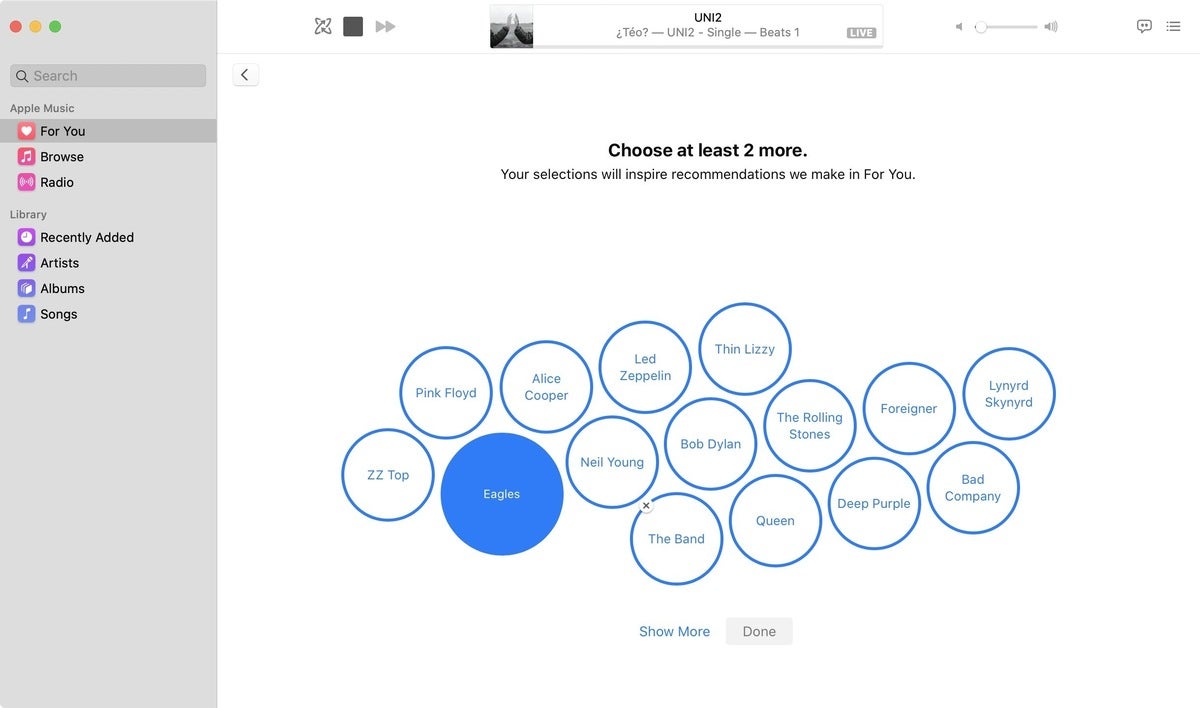
When you sign up for Apple Music (macOS Catalina shown here), you’ll be asked about the types of music you like and your favorite artists. This is used to get started on the curation of the music the service feeds to you.
Apple Music’s library has over 90 million songs. Oh, and you can also watch music videos without ads, and check out Apple’s exclusive original content.
Apple Music used to have an artist-based social networking feature called Connect. Artists were able to share special content with fans through Connect. For example, hip-hop artist Drake used the service to post behind-the-scenes photos of his life, share snippets of new songs, and other content. But Apple discontinued the Connect service.
How much does this cost? Apple Music costs $9.99 per month, or $14.99 per month for a family subscription for up to six people (which requires iCloud Family Sharing). College students can subscribe for $4.99 per month. A new Apple Music Voice plan, with limited functionality, became available with iOS 15.2 and macOS 12.1 for $4.99.
Can I try before I buy? Yes. Apple offers a free trial for new subscribers. If you cancel during the trial, you do not get another opportunity at a free trial. The trial length varies, but is typically about three months for new subscribers.
Is there a free, ad-supported version? Sadly, no. Some aspects will be available to anyone who logs in with an Apple ID—namely, Beats 1, and the ability to listen to Apple Music radio stations with a limited number of skips. But a paid subscription is required to access Apple Music’s library.
What devices can I use this on? Apple Music is available for all iPhones, iPads, and iPod touch models that are running iOS 8.4 or later. It’s also available on the Mac and PC (via iTunes 12.2 or later, or through the Music app starting with macOS Catalina), Apple TV (running tvOS 9 and newer), and on Apple Watch. Android users can join in on the fun, too, if their device is running Android 4.3 (Jelly Bean) or newer. Apple Music is available on several smart TVs and streaming boxes, as well as some game consoles. Apple Music Voice is only supported on Apple devices, however.
Wait, did you say Android? Yes! Android users can sign up and have access to Apple Music’s complete catalogue, but they’ll miss out on its full array of features (like voice commands). Music for all!
Does it work with AirPlay? Yes! Each song or music video has an AirPlay button next to it—just tap it and select the device you want to beam to.
Which countries have access to Apple Music? Apple Music is available in more than 100 countries worldwide, including the U.S., Canada, the U.K., Australia, Japan, Brazil, and India. Check out Apple’s complete list for more info.
What is Apple Music Voice? A less expensive ($4.99/month) subscription option that focuses on voice commands. You can use your voice to request any song, album, artist, or any of hundreds of Apple-curated playlists. So you have access to the whole song catalog, but you can’t make your own playlists, use Spatial Audio or Lossless Audio, see lyrics, or download songs to your library for offline playback.
Moving to Apple Music from other streaming services
I have an iTunes Match subscription. If I subscribe to Apple Music, do I still need iTunes Match to keep my complete music collection together? According to Apple, iTunes Match and Apple Music are completely separate services, so it will be up to you to decide if you’d like to keep iTunes Match. If your personal music collection has a lot of rare tracks and content that you can’t get through Apple Music, then you may want to consider keeping both subscriptions. Check out our explainer to learn more about how Apple Music and iTunes Match work together.
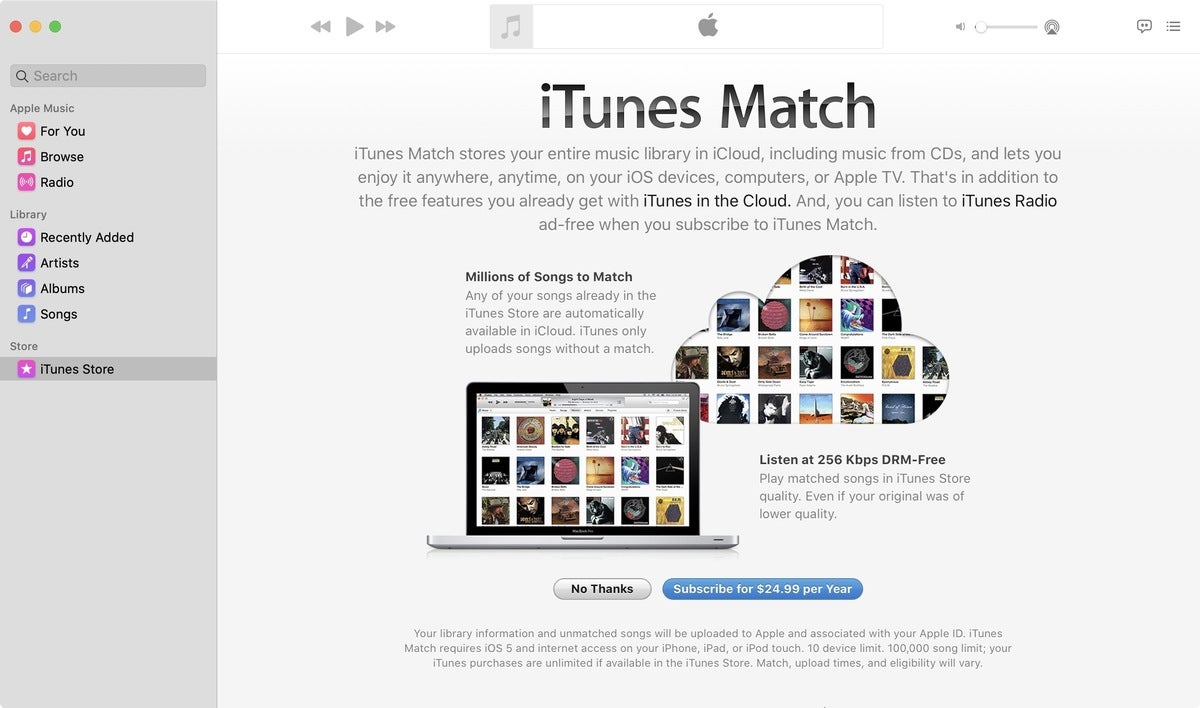
Apple still offers iTunes Match, a service that lets you store the music that you own in iCloud. You can then access it anywhere you have an internet connection.
I spent years perfecting my playlists on Spotify and iTunes. Can I import these into Apple Music? Your iTunes playlists will automatically be pulled into Apple Music when you set up your account, as will the rest of your iTunes library.
However, if you use Spotify, Google Play Music, or any other music subscription service, you’re out of luck. There is no easy way to directly import your playlists into Apple Music. There are some third-party playlist importers out there, like Stamp, but your mileage may vary.
Music 101: Quality, compatibility, offline listening, and more
How’s the music quality? Apple Music streams songs at 256kbps, which is the same rate as iTunes Match. That’s a bit of a drop from Spotify, which uses a 320kbps bitrate. Select Apple Music tracks and albums are available with Apple Music Lossless at no extra charge. But the big advantage of Apple Music is the newer Spatial Audio feature for select music. It’s not available for most of the 90-million song catalog, but it makes a big difference for those tracks where it is available.
Does Apple Music work with Apple’s HomePod? It sure does, but you need an Apple Music subscription to control your music via Siri.
Does Apple Music link with Sonos? Yes! If you have Sonos speakers set up in your home, getting started with Apple Music streaming is easy. Just open the Sonos app and choose “add music services.” Select Apple Music and log in.
Can I save music to listen to offline? Yep! Apple Music lets you save tracks to listen to offline—you can save as many songs as you’d like, as long as your device has space for them.
But remember: You won’t own those files and you won’t be able to offload them anywhere else. You can’t burn them onto a disc, use them in separate video projects, or put them on other devices that aren’t linked to your Apple Music account. If you decide to cancel your Apple Music subscription, you’ll lose access to those songs.
The offline listening feature is a great option if you’re concerned about data overages, or if you know you’ll be in an area without a good wireless connection.
How does Apple Music 1 differ from iTunes Radio? iTunes Radio takes the Pandora-style approach to radio, where users create their own stations based around songs, artists, albums, or genres, and iTunes serves up songs that flow well around that theme. You can still use a version of iTunes Radio within Apple Music—but it’s now called Apple Music radio stations. However, iTunes Radio stations were built by algorithms, and Apple Music’s radio stations are mostly hand-curated.
Apple Music 1, on the other hand, is more like a traditional radio station, with a 24/7 live radio stream anchored by DJs based in New York, Los Angeles, and London. Former BBC personality Zane Lowe is leading the effort from Los Angeles, with Ebro Darden of Hot 97 in New York, and Julie Adenuga in London. Apple Music 1 features a combination of songs handpicked by these DJs, plus celebrity interviews, pop culture news, and other music-related content.
What’s really neat is that every user around the world hears the same content at the same time, and these stations take a much more curated approach to radio than iTunes Radio does.
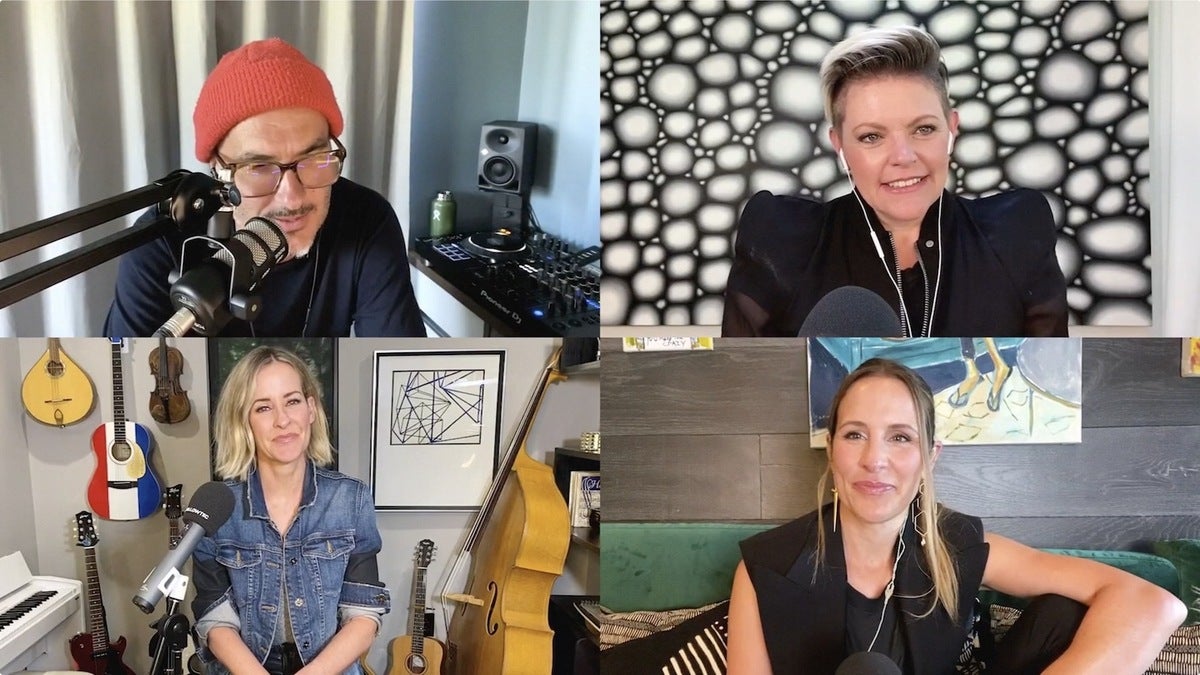
Apple Music 1 has interviews with artists, such as this Gaslighter interview with The Chicks.
Will standalone iTunes Radio remain a free service? Will iTunes Radio stations sponsored by record labels be moving to Apple Music, or will they be dropped? Apple Music 1 and Apple Music’s radio stations are free to anyone with an Apple ID—though the genre- and artist-based radio stations will be ad-supported and have a limit on song skips. If you created your own stations, they’ll sync over, and you can find them in the Radio tab. However, many of iTunes Radio’s former stations sponsored by record labels have disappeared, so you may be out of luck.
For more, check out our how-to on personalizing your own Apple Music radio stations.
What genres does Apple Music 1 focus on? Apple Music 1 doesn’t really focus on one specific genre like traditional AM/FM radio stations do. On any given day, you’ll hear a healthy mix of indie rock, hip-hop, pop, funk, electronic, classic rock, dance music, and more, all artfully woven together in a way that doesn’t sound like a hot mess. DJ Zane Lowe mentioned in the station’s opening remarks that
Apple Music 1 is simply about great music, and it serves as a solid jumping off point for discovery.The Apple Music 1 DJs also select one track as their daily World Record, and that song gets played hourly on the half-hour mark. Besides the daily rotation of DJs,
Apple Music 1 includes special programming from other artists as well. For example, it aired interviews with 2021 Apple Music award recipients The Weeknd, H.E.R., and Olivia Rodrigo.How do I add songs from
Apple Music 1 to playlists? Heard a song on Apple Music 1 that’s so good, you know you’ll want to listen to it again? Here’s how to track it.iOS/iPadOS:
-
While listening to Beats 1 or another Apple Music radio station, tap on the song listing at the bottom of the screen, but above the control panel.
-
A song panel should fill the screen, with cover art, the song and artist names, and player controls. Tap the three-dot button next to the song and artist names.
-
A task list should appear. One of the tasks is “Add to a Playlist.” Tap that one.
-
A list of your playlists will appear. Tap the one to which you want to add the song. You’ll see an Added to Playlist pop-up to confirm that the action was performed.
Now, if you go to that playlist (Library > Playlists), you’ll see the song there.
Mac:
-
While listening to Apple Music 1 or another Apple Music radio station, right-click the song in the now playing section at the top of the Music app. Or, move your cursor over the song name in the now playing section, and then click on the three-dot button that appears.
-
A pop-up menu will appear. Select Add to Playlist.
-
A list of you playlists will appear. Select the playlist to which you want to add the song, or select New Playlist to start a new playlist. At the bottom of the Music sidebar, an alert will appear to tell you that the song is being added to the playlist.
That’s it. When you click on the playlist in the sidebar, you should see that the song has been added.
Is there a limit to the number of songs you can have in a playlist? Not that we’re aware of! Add away.
How do you tell it what songs you don’t like? When listening to a playlist or radio station, you can skip any song you don’t like (except for in
Apple Music 1, which is live). While this should signal to Apple Music that you don’t want to hear that song or artist again, it might be finicky at times. You can hit the three dots menu (…) and choose “Suggest less like this” to show your displeasure.When a song is playing, how can you go to that artist page, or album? This used to be quite complicated, but Apple has since made it much easier—just tap/click on the artist’s name.
Where do songs or artists show up when you add them to my Library? They automatically appear in the Library tab, where you can sort your collection alphabetically by artist, album, or song title. You’ll also find all of your playlists, and your list of downloaded music saved for offline listening. Scroll down to find your recently added music.
Why is there stuff on the iTunes Store that isn’t on Apple Music? It all comes down to the deals Apple has made with various artists and record labels. Some artists are not interested in streaming services.
What about podcasts? Apple makes podcast available through its Podcasts app on the iPhone, iPad, iPod touch, and Mac.
Can I use Apple Music through the web? Yes, there is a web interface. In your web browser, go to music.apple.com. You can log into your account and access you playlists, songs, and more. The web interface is a lot like the Music app for the Mac, and it’s a handy way to access your music when you’re not using one of your own devices. Don’t forget to log off if you’re using computer that others can use.
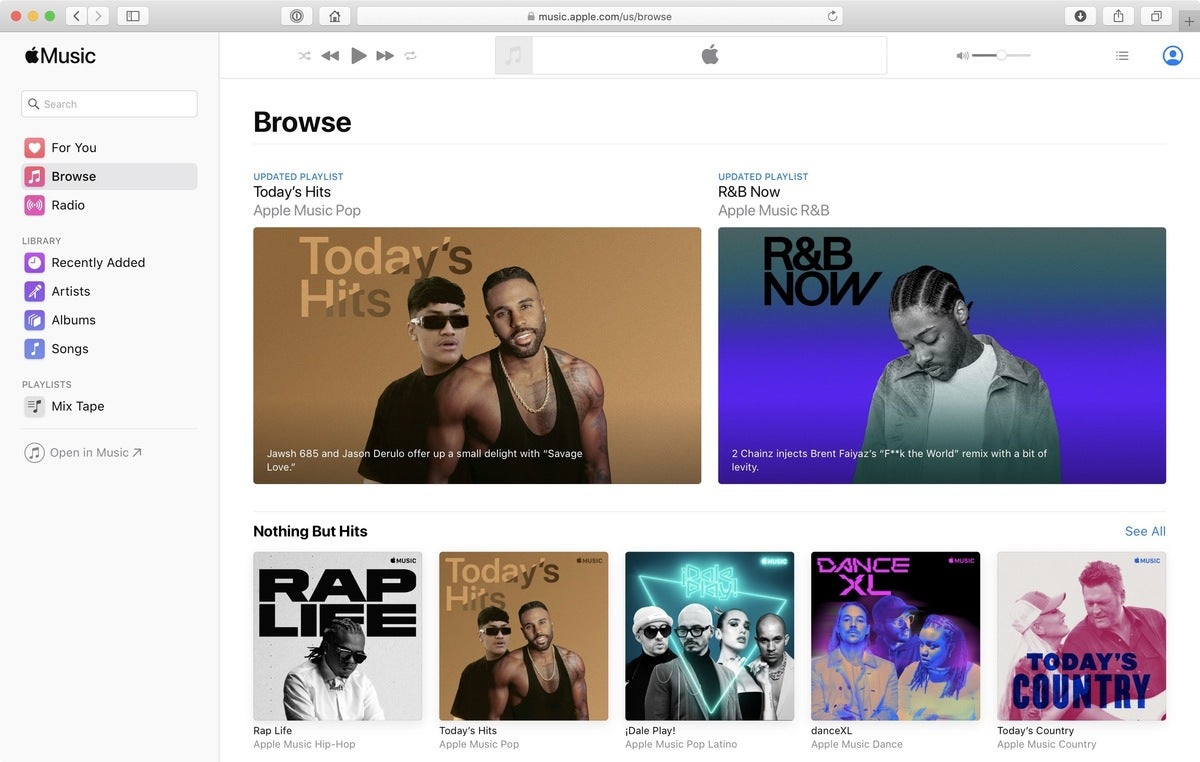
How do I cancel my free trial subscription before Apple charges my credit card? We have a separate article that details how to cancel your Apple Music and other Apple subscriptions, but the gist is that you’ll need to take a trip to your Account Settings on whatever device you use.
"complete" - Google News
December 14, 2021 at 05:03AM
https://ift.tt/31WqmN2
The complete guide to Apple Music: Get the low down before you sign up - Macworld
"complete" - Google News
https://ift.tt/2Fvz4Dj
https://ift.tt/2YsogAP
Bagikan Berita Ini
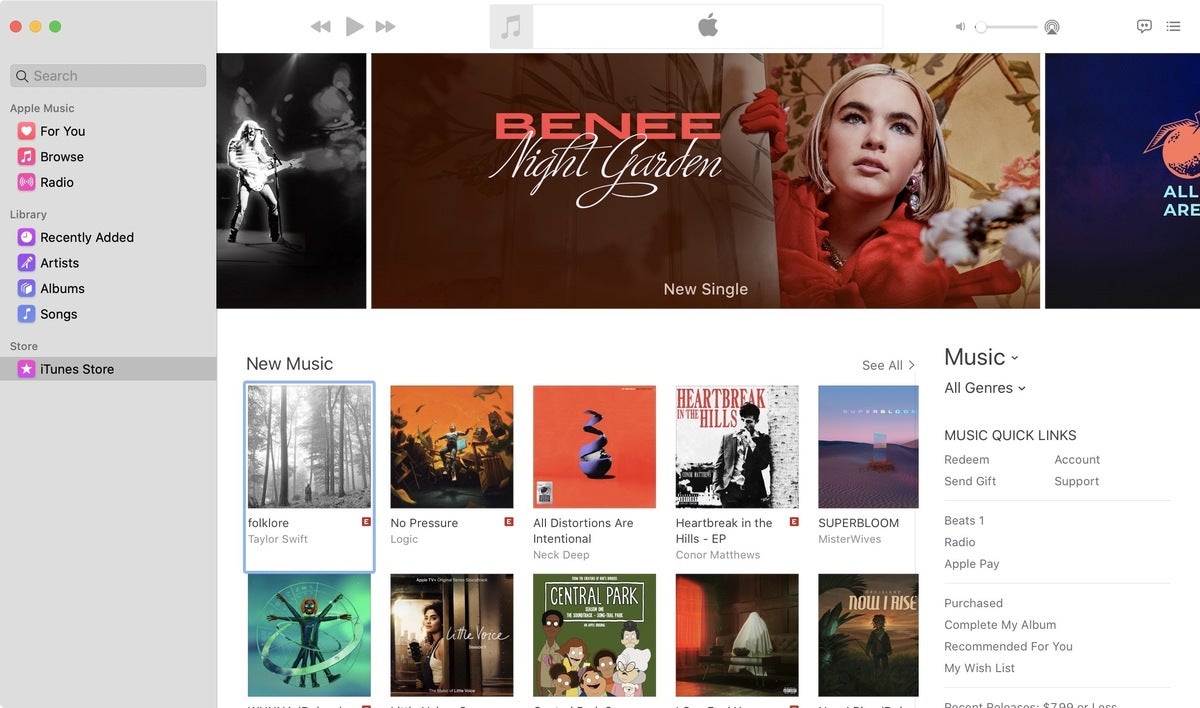
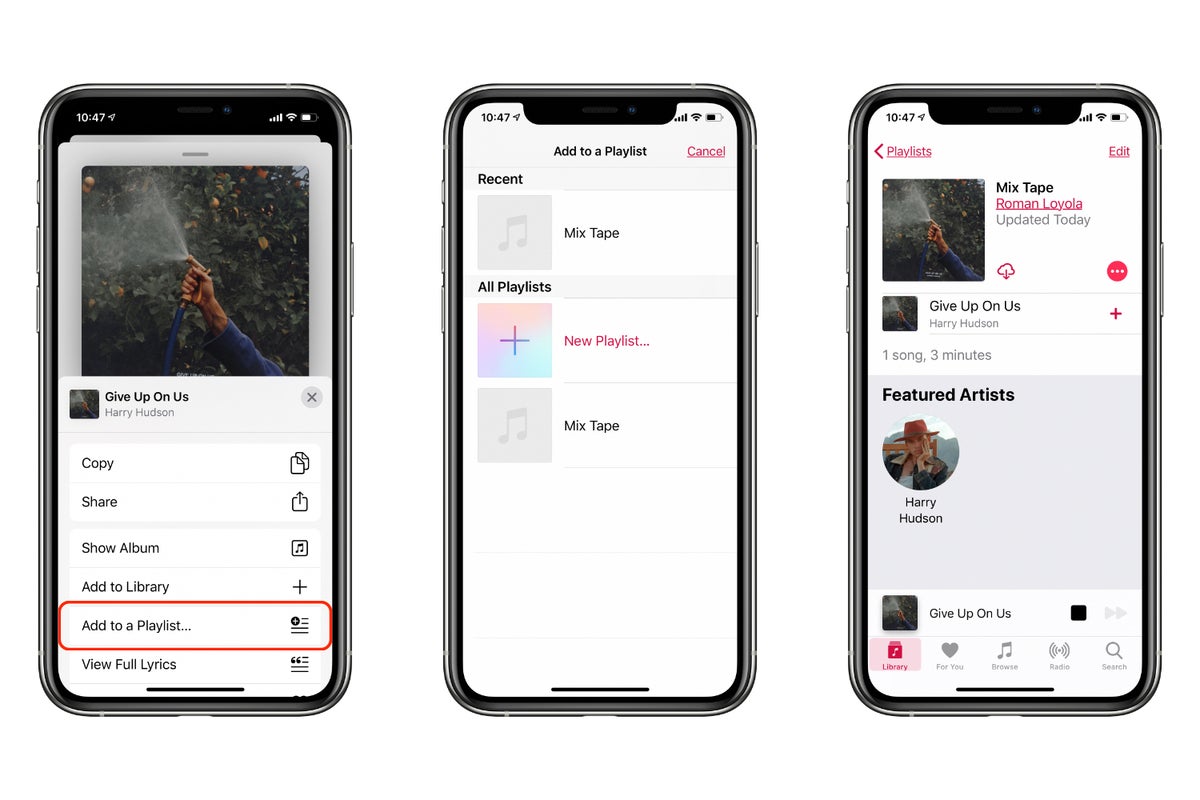
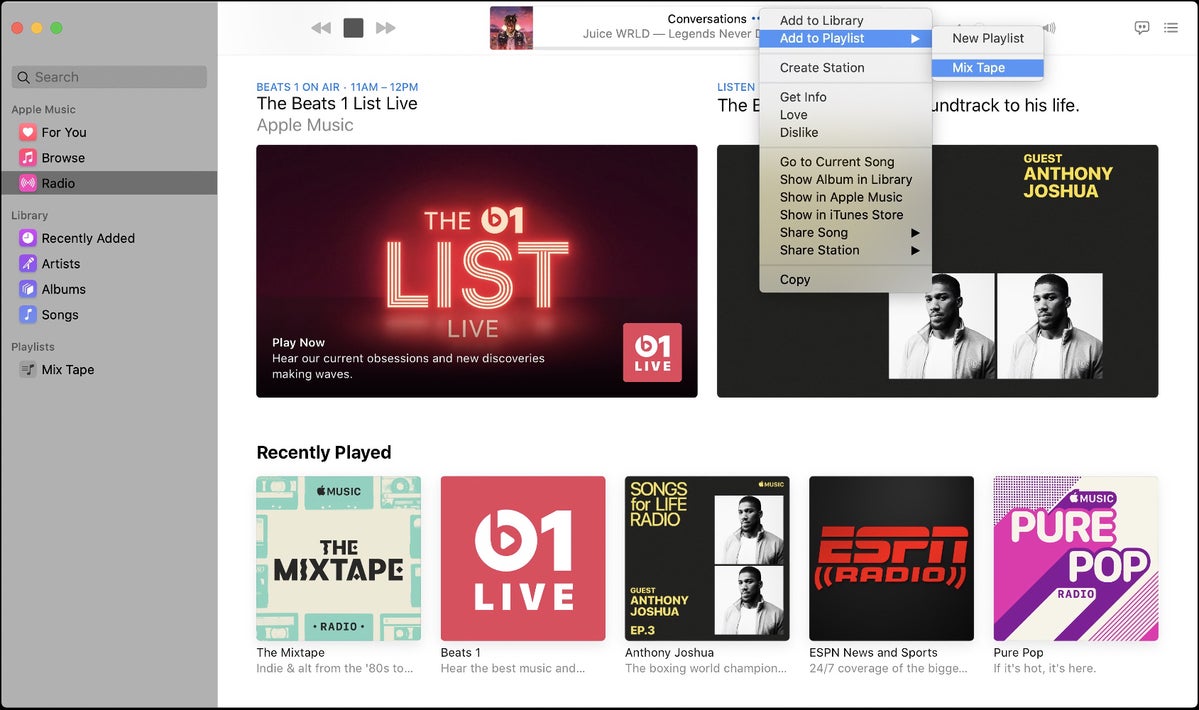














0 Response to "The complete guide to Apple Music: Get the low down before you sign up - Macworld"
Post a Comment